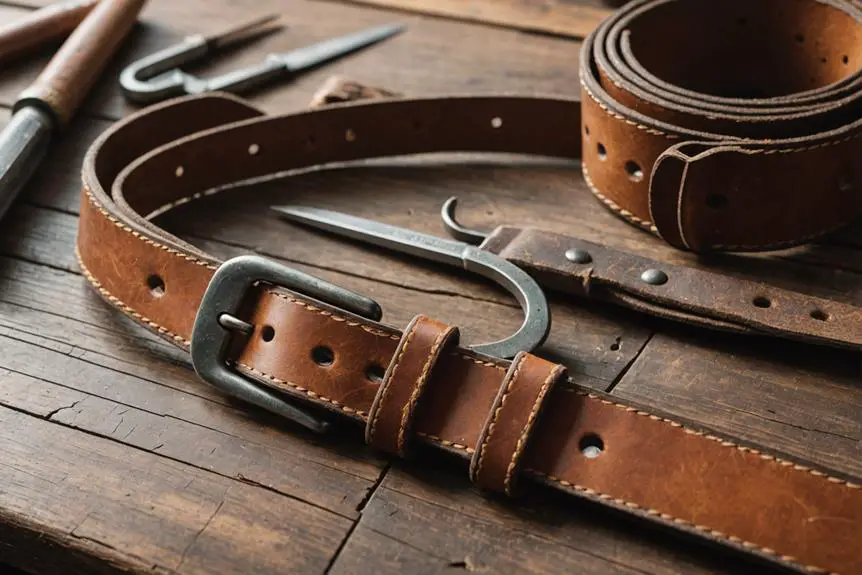Fixing ripped belt loops in leather belts isn't as challenging as it sounds, and hey, you can totally do it! Start by checking out the damage; make sure you note any frayed edges or weak spots. Grab some sturdy fabric for backing, matching thread, and a sewing machine or needle. Pin the backing to the belt, then stitch it up tight and neat. Don't forget to tie off the thread to keep everything secure! Regular checks on your belt loops will help you avoid future rips. Stick around, and you'll uncover more tips to keep that belt in tip-top shape!
Assessing the Damage
When you notice a ripped belt loop, the first step is to evaluate the damage thoroughly. You can't just ignore it and hope it'll magically fix itself, right? Start by inspecting the area around the belt loop. Look closely for any rips or tears, especially where the loop attaches to the belt. This'll help you figure out how serious the damage really is.
Next, check for signs of fabric failure. Are there any frayed edges or thin spots? If so, your belt loop might be at risk of completely detaching. Yikes! Also, take a moment to review the stitching quality around the belt loop. If it looks weak or damaged, that's another red flag. You want sturdy stitching to keep that loop in place.
Don't forget to measure the size of the rip. Is it a small tear that can be patched up easily, or is it a larger issue that needs a complete reattachment? Knowing this will guide your next steps. And while you're at it, take a look at the overall condition of the belt itself. If the leather's worn out or cracking, you might need to think about repairs beyond just the belt loop. After all, a sturdy belt is key to keeping your pants up! So, grab a trusty flashlight, and let's plunge into evaluating that damage like a pro!
Materials for Repair
To successfully repair ripped belt loops, you'll need a few essential materials. This isn't just a casual DIY project; it's a chance to save your favorite leather belt and show off your crafty side! Here's what you'll need:
| Material | Purpose |
|---|---|
| Sturdy woven fabric | Acts as a backing piece to reinforce the loop |
| Matching thread | Guarantees a seamless look or adds a pop of color |
| Quality sewing machine | Makes stitching efficient and durable |
| Pins | Secures the backing fabric to the leather |
| Scissors | Cuts fabric and thread to the right lengths |
First up, grab some sturdy woven fabric. This will be your secret weapon! It supports the damaged belt loop, keeping it strong and lasting longer. Next, choose thread that matches your belt's color for that flawless look. If you're feeling adventurous, go for a contrasting thread—it'll give your repair a fun touch.
You'll also want a quality sewing machine to make your life easier. Trust me, it'll save you tons of time and effort! Don't forget pins; they'll hold everything in place while you stitch. Finally, a good pair of scissors is a must for trimming the fabric and thread to the right size.
Now that you're armed with the right materials, you're ready to tackle that ripped belt loop! Isn't it exciting to think about how great your belt will look again?
Repair Techniques
Repairing ripped belt loops can be straightforward and rewarding, especially with the right techniques. First, grab a sewing awl or a sturdy needle and some strong thread. You'll be amazed at how easily worn threading in leather belts can be fixed! Start by reusing the existing holes when you sew. This step not only keeps your belt's integrity intact but also gives you a neat finish.
Now, let's get stitching! Make certain your stitches are tight and consistent. Think of it like a game—if you want your repair to last, you've got to play it right! A good stitching job can prevent future damage and even make your belt look better than before. When you finish up, tie off the thread by pulling it through multiple layers. This little trick adds extra security and makes your repair feel like it's ready for anything, just like those belt straps you love.
Don't forget to repeat the stitching process across the loop. This repetition guarantees that your repair is uniform and strong, making it less likely to wear out. You want your belt loop to be able to handle your daily adventures, right? So, grab your tools, channel your inner DIY expert, and get ready to bring your trusty belt back to life! You'll be proud of the work you've done, and your belt will thank you for it. Happy repairing!
Reinforcing the Belt Loop
After you've stitched up your ripped belt loop, reinforcing it can provide that extra layer of strength you need for long-lasting use. Trust me, you don't want to go through this process again anytime soon! Start by cutting a backing piece of sturdy woven fabric, making it about 1 to 1.5 inches larger than the damaged area on each side. This guarantees full coverage. By making diagonal cuts on the edges, you'll help prevent raveling, which is a sneaky way to extend the life of your belt loop.
Next, secure the backing fabric to your pants using pins. This keeps everything in place while you stitch, making your life a whole lot easier! Grab your sewing machine and get ready to work some magic. Stitch around the hole with matching thread, and try using a cross-hatching pattern. This not only reinforces the area but also helps obscure the damage—like a little disguise for your belt loop!
Once you've finished, take a moment to inspect your handiwork. Is everything sturdy? Does it look good? If it does, congratulations! You've just given your belt loop a fighting chance. And hey, don't forget to check the condition of your belt loops regularly. A little maintenance goes a long way in preventing future issues. So, go ahead and rock that belt with confidence!
Tips for Successful Mending
Mending a ripped belt loop can be a straightforward task if you keep a few essential tips in mind. First off, make sure you securely pin that backing fabric to the leather belt before you start stitching. You don't want it shifting around on you—that's just a recipe for disaster! Next, get familiar with your sewing machine's reverse function. Using it at the beginning and end of your stitching will give you stronger seams, which can handle all the stress your belt loop has to bear.
Now, let's talk about the spacing of your stitches. Keeping it consistent not only makes your repair look professional, but it also boosts durability. Who wouldn't want their belt loops to last longer? Once you finish, take a moment to inspect your handiwork. Check for tight stitching and make sure the fabric backing is nicely integrated with the belt. You want it to look good, too!
Frequently Asked Questions
How to Fix a Leather Belt Loop?
To tackle a leather belt loop, assess the damage first. For belt loop repair, you can stitch or use rivets for reinforcement. Regular maintenance will keep it looking great and prolong its lifespan.
How to Fix a Ripping Leather Belt?
When tackling a ripping leather belt, assess the damage first. For effective belt restoration, stitch the edges tightly or use a leather patch for extensive rips, ensuring a durable and lasting repair you can rely on.
What Kind of Glue to Repair Leather Belts?
When repairing leather belts, consider adhesive options like strong contact cement or polyurethane-based glue. These provide durability and flexibility. Avoid white glue; it won't hold up well over time. Always clean surfaces before applying.
Can You Sew on Belt Loops?
Yes, you can sew on belt loops using various sewing techniques. Whether by machine or hand, make certain you remove old stitches and use double rows for durability, achieving a neat finish with careful alignment.




